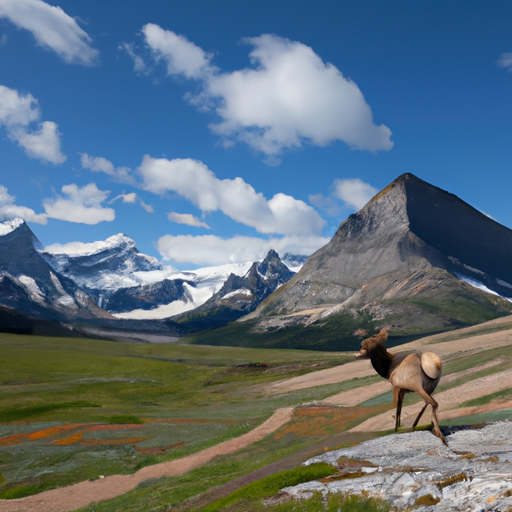 Introduction:
Introduction:
High altitude environments are characterized by low oxygen levels, extreme temperatures, and reduced atmospheric pressure. These harsh conditions pose significant challenges for survival, making it essential for animals to adapt in order to thrive in such habitats. Over the course of evolution, various species have developed remarkable physiological, anatomical, and behavioral adaptations to overcome the constraints of high altitude environments. In this article, we will delve into the fascinating world of animal adaptation to high altitudes, exploring the mechanisms that allow them to survive, reproduce, and thrive in these extreme conditions.
1. Oxygen Transport and Utilization:
One of the most critical challenges faced by animals at high altitudes is oxygen deficiency. The partial pressure of oxygen decreases with increasing altitude, resulting in reduced oxygen availability for respiration. To compensate for this limitation, animals have developed numerous adaptations:
a. Increased Red Blood Cell Production: Animals living at high altitudes often possess higher red blood cell counts, allowing for more efficient oxygen transport to vital organs. This adaptation helps to maintain oxygen saturation levels in the blood, ensuring that tissues receive an adequate supply of oxygen.
b. Enhanced Hemoglobin Affinity: Some animals exhibit adaptations in their hemoglobin structure, which increases the affinity for oxygen, facilitating efficient oxygen uptake at low partial pressures. This characteristic enables animals to extract more oxygen from the limited available supply.
c. Enhanced Capillary Density: Certain species, such as high-altitude birds, have a greater density of capillaries in their tissues. This adaptation enhances oxygen diffusion from the blood vessels to the tissues, maximizing oxygen delivery to vital organs.
2. Respiration and Metabolism:
To cope with the low oxygen levels, animals at high altitudes have developed specialized respiratory and metabolic adaptations:
a. Larger Lung Capacity: Many high-altitude mammals possess lungs with larger surface areas and greater volumes, allowing for increased oxygen uptake during respiration. This adaptation enables them to extract more oxygen from each breath, compensating for the reduced atmospheric oxygen content.
b. Efficient Oxygen Utilization: High-altitude animals have evolved efficient mechanisms to utilize oxygen. They exhibit reduced metabolic rates, enabling them to conserve energy and minimize oxygen demands. Additionally, some species have adaptations that promote anaerobic metabolism, allowing them to derive energy even in oxygen-limited environments.
c. Hyperventilation and Altitude Acclimatization: Some animals exhibit rapid and deep breathing, known as hyperventilation, to compensate for low oxygen levels. Additionally, many species undergo altitude acclimatization, a process where their respiratory and metabolic systems adapt gradually to the reduced oxygen levels, optimizing oxygen usage over time.
3. Thermoregulation:
High-altitude environments often experience extreme temperatures, including frigid winters and scorching summers. Animals in these regions have evolved several thermoregulatory adaptations to combat these temperature fluctuations:
a. Insulation: Many high-altitude mammals possess thick fur or feathers, providing insulation against the cold. This adaptation helps to retain body heat and prevent excessive heat loss in freezing temperatures.
b. Reduced Surface Area: Some species have compact body shapes with reduced surface areas, minimizing heat loss. This adaptation is particularly advantageous in cold and windy environments.
c. Countercurrent Heat Exchange: Certain animals, such as penguins, have developed countercurrent heat exchange systems in their extremities. This mechanism allows warm arterial blood to transfer heat to cold venous blood, conserving body heat and preventing excessive cooling in extremities.
4. Behavioral Adaptations:
In addition to physiological and anatomical adaptations, animals at high altitudes have also developed behavioral strategies to enhance their survival:
a. Seasonal Migration: Many high-altitude animals undertake seasonal migrations to lower altitudes during harsh winters, where food resources are more abundant and temperatures are less severe. This migration allows them to avoid the challenges posed by extreme cold and limited food availability.
b. Nesting Habits: Some bird species choose to nest in sheltered locations, such as cliffs or burrows, to protect themselves from the harsh weather conditions at high altitudes. These nesting habits provide them with insulation and reduce exposure to extreme temperatures.
c. Feeding Strategies: High-altitude animals often adapt their feeding strategies to cope with limited food availability. Some species store food during abundant seasons, while others have specialized diets that allow them to exploit unique food sources present at high altitudes, such as alpine plants or insects.
Conclusion:
The adaptation of animals to high altitude environments is a testament to the extraordinary resilience and flexibility of nature. Through a combination of physiological, anatomical, and behavioral adaptations, these remarkable creatures have conquered the challenges of low oxygen levels, extreme temperatures, and reduced atmospheric pressure. Their ability to thrive in high-altitude habitats serves as a constant source of inspiration for scientists and a reminder of the wonders of evolution. By understanding these adaptations, we gain valuable insights into the delicate balance between organisms and their environments, fostering a deeper appreciation for the intricate interplay of life on our planet.
